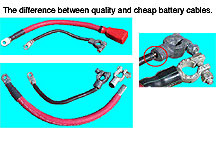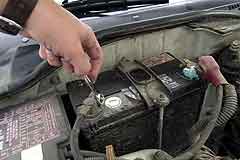Checking your battery before you start out on that next trip can save you lots of grief on the road. Checking here means a bit more than just peeking into the filler holes to see if there is sufficient water.

First, a word of caution. Batteries give off two very explosive gases - hydrogen and oxygen. Consequently, do not smoke or work with open flames around a battery. Also the electrolyte is highly corrosive so avoid contact with your skin or clothing. If it happens, wash it off immediately with large quantities of water or neutralize with a baking soda solution. For maximum protection, wear goggles.
A significant reason for dead batteries is accumulated dirt that collects moisture that aids current leakage. Batteries and terminals can be cleaned using commercially marketed battery cleaners, a baking soda solution or ammonia. Be careful not to let any cleaning fluid get into the battery itself since even a few drops can substantially decrease the battery's efficiency and even affect its life.
Battery cables and connections should be checked for corrosion and tightness. It only takes a very thin film of dirt between the cable clamp and battery post to decrease the flow of current. Remove terminals from battery posts and scrape them clean using a knife, wire brush or a tool specifically designed for the job.

Replace corroded and frayed cables. When replacing battery cables, buy the highest quality ones. Some cheap replacement cables use small gauge wire encased in thick insulation. While the cables may look the same from the outside, the smaller wire inside cannot pass as much current when needed to start a very cold engine. This is also the difference, and end result, between cheap and expensive jumper cables.
Make sure that the battery is securely mounted in the vehicle. The plates in a battery can be severely damaged by bouncing. The plates in a battery can be severely damaged by bouncing around for even just a few miles.
Fill each cell to just over the top of the cells. Do not overfill because you can lose some of the electrolyte. The corrosive water/battery acid mixture will also corrode both painted and unpainted surfaces, and do it quickly. Use distilled water if possible, but at least use clean water.
If you find that you have to add water frequently, suspect cracked cells or an excessive charging rate and a need for a charging system checkup. Other indications of charging system problems are acid buildup on the outside battery surfaces and on terminals, and in extreme cases, bulges in the battery indicating the positive plates have swelled. Both overcharging and under-charging can be fatal to batteries.
If the battery requires a recharge, a slow charge is far better than a "quick charge." Indeed, a badly sulfated battery can even explode when given a quick charge. Normally, a battery should be charged at a rate that is no more than 10-20 percent of its rated capacity.
For example a battery rated at 54 ampere-hours should use a 5.4 to 10.8 ampere charging rate. By contrast, a quick charger will pump in current at rates of 35 to 50 amperes. Lesser rates, like available from inexpensive home chargers, will do the job if you have the time, and they are much more "battery friendly."




